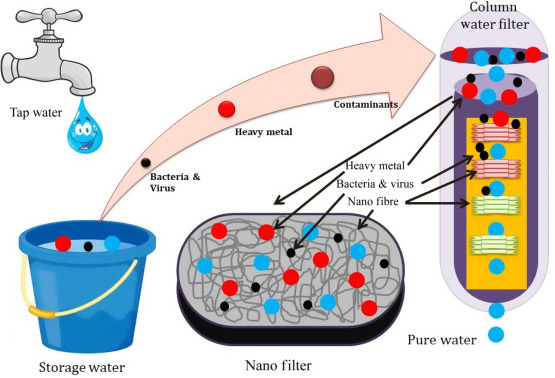
Heavy metals are ubiquitous in the air, soil, and water. Such levels came into existence from extraction of metals, industrial sewages, agricultural fertilizers, batteries, and electronic industries.1 Since water and hydration are essential to maintaining human health, it is equally critical to ensure drinking water quality. The following will explore water filtration as a means of achieving the same.

Drinking water is defined as water with biological and physiochemical standards which its short and long-term use is devoid of complications to human beings.1(718)Furthermore, drinking water should be clear and free of turbidity (cloudiness) and have permissible levels of chemicals and microbes.1(718) Since heavy metals do not degrade in the soil and water, they tend to bioaccumulate within the human body, and metals such as arsenic (As) has contaminated drinking water sources of millionsof people worldwide.1(718)Such exposure to As is problematic because it is a non-essential element and can induce toxic affects by displacing zinc (Zn) absorption.1(718) Even a modicum of Cd in the human body has been known to cause kidney damage and cancer, thus avoidance and management is critical.1(718)

Water filtration can be an effective means of filtering out heavy metals like As, as well as nitrates from agricultural fertilizers; such a substance can convert iron 2+ (Fe2+) to Fe3+ negatively effecting oxygen transport in hemoglobin.1(718) However important water filtration is, such a method of purifying water is only as good as the filtration system design. Pourjamali et al1(718) conducted a cross-sectional study whereby water quality at the inlet (water entering the home) and point-of-use (water coming out of the filter) were analyzed.1(718) Two brands of water filtration systems (using reverse osmosis) were considered, and 4 households using the 2 brands were identified. Water at the inlet and outlet of the device was sampled at 15-day intervals for 3 months during the summer in six steps; a total of 48 samples were collected by the end of the study.1(718)
Both water filtration devices maintained standard limits of water hardness, calcium, sodium, and magnesium levels. Additionally, copper (Cu), Zn, and lead (Pb) were lower than those compared to the inlet levels suggesting effective removal.1(724) Most relevantly, As levels were significantly reduced compared to the inlet levels and were 5 times lower than the Iran standard limit.1(720) Thus, using water filtration methods appears to be an effective means of controlling toxin and heavy metal exposure.
References
1. Pourjamali R, Sadrabad EK, Hashemi SA, et al. Evaluation of point-of-use drinking water treatment systems efficiency in reducing or removing physiochemical parameters and heavy metals. JEHSD. 2019;4(1):717-726. doi.org/10.18502/jehsd.v4i1.490.
2. Sears ME, Kerr KJ Bray RI. Arsenic, cadmium, lead, and mercury in sweat: A systematic review.J Environ Public Health. 2012. doi:10.1155/2012/184745.
3. Wang S, Wu W, Liu F. Assessment of the human health risks of heavy metals in nine typical areas. Environ Sci Pollut Res. 2019;26(12):12311-12323. doi:10.1007/s11356-018-04076-z.
4. Lord RS, Bralley, JA. Laboratory Evaluations for Integrative and Functional Medicine (2nded.). Duluth, GA: Genova Diagnostics; 2012.
-Michael McIsaac
